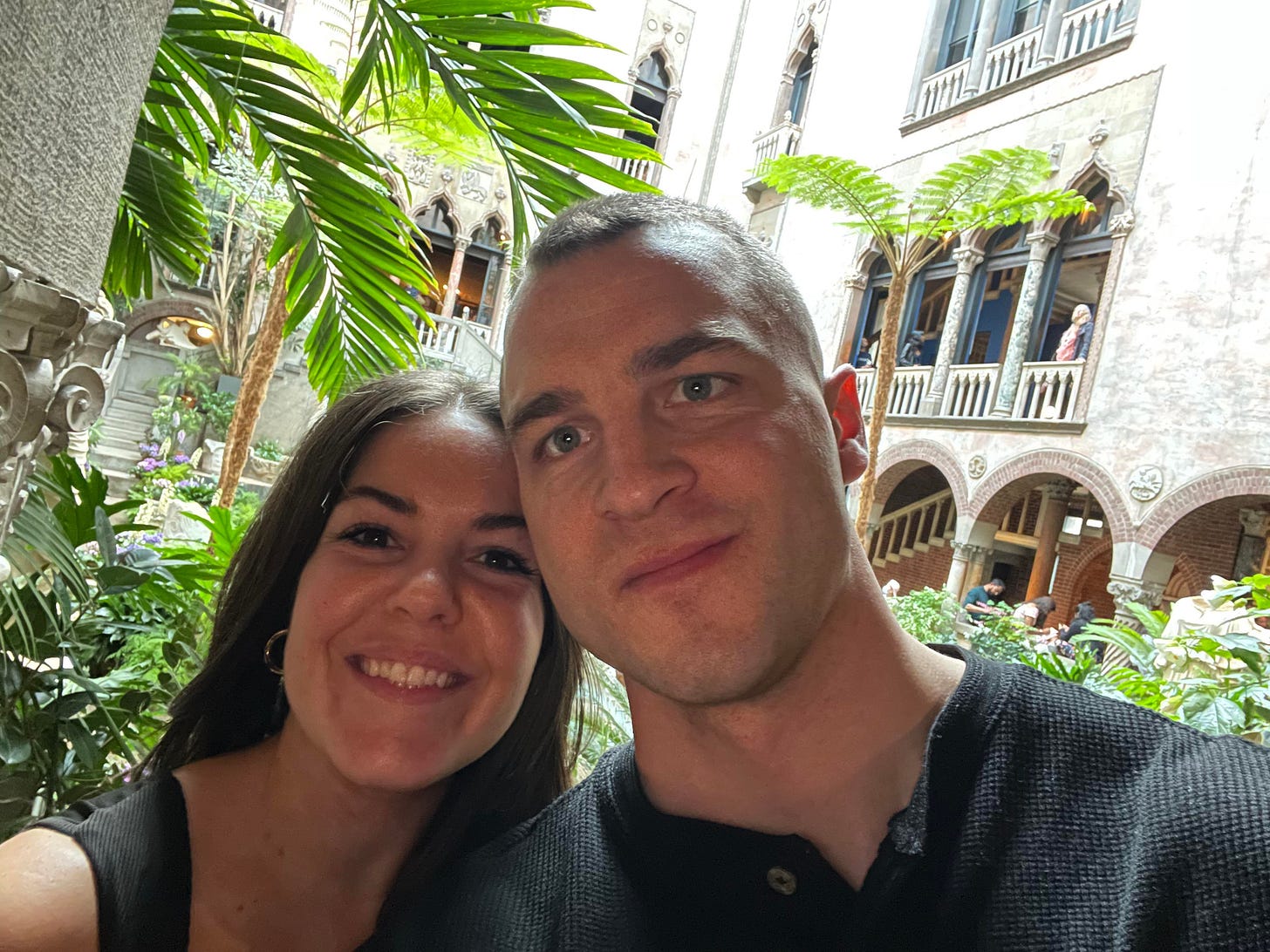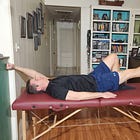How to avoid back surgery
This is not medical advice.
I met this guy Noah online. We have been discussing rehab protocols for treating low back pain. He believes he has a disc herniation, and has been successfully decreasing his pain with this protocol.
His story is so good and fascinating, I asked to interview him for this article. I will never say that everyone can avoid surgery, however it is worth considering some of the points in this protocol.
Even if you end up having surgery, some of the points made here will help you to decrease the likelihood of symptoms returning.
Some readers will see some heavy weightlifting, and think this doesn’t apply to their low back pain. Yet the premise of back stabilization and helping yourself avoid back surgery is the same. I have a link below for the majority of back pain cases that I see, in the 40-80 year old range.
Even if you are not Noah’s age, or a weightlifter, I highly encourage you to read Noah’s story, as he puts all the pieces of the puzzle together. I have seen many people with horrible looking MRIs and x-rays become pain free with gentle back stabilization exercises.
Hi Noah! I have several questions about your back pain, but first wanted readers to understand your exercise and/or sport history.
I was always an active kid, and played baseball all throughout childhood, and ultimate frisbee up until my early 20's. I bounced around with cardio and biking and weights, but really got into lifting weights in 2017 and was my main form of exercise along with hiking.
You made several comments that really stuck out for me. One was that you haven’t received an official diagnosis, and don’t necessarily need one, and that others have been pressuring you to get an MRI.
Just through general observation and looking on online forums, I noticed that a lot of patients and athletes, especially with back pain, would receive an MRI that pointed to bulging discs and "degenerative disc disease" and then the focus would change to that specific diagnosis rather than addressing the symptoms (bold is my emphasis). In some cases, this could become a "doom and gloom" situation where the reason they have pain is because of X diagnosis.
On the flip side, it seems that athletes seem to recover the fastest and while it certainly helps, I don't think having access to specific resources was always the main reason for their fast recovery. Rather, having a bias for action, treating the symptoms present, and addressing the weakness/deficiency that caused the injury in the first place are what really allow the athletes to conquer injuries and return to sport.
I have had some overuse injuries in the past and after recovering from a bout of golfer's elbow in the past with some good old PT, I knew that the answer to fixing my back would not come from pills, surgeries, or injections, and that I had glaring weaknesses in my movement patterns, and programming that caused my back injury in the first place.
At the start of this year, I vowed to learn all I could about my injury and took a deep dive into reading about spine rehab, especially from the esteemed Dr. Stuart McGill. I have also had the fortune of working directly with Brian Carroll, who recovered from a devastating back injury due to cumulative loads from lifting and some trauma outside the gym and went on to set the world record for the heaviest squat of all time.
Brian is overseeing all of my current programming and rehab plan as he has been through this himself, all without any surgical intervention thanks to Dr. McGill's expertise.
With Brian's guidance, I am on a rehab plan to continue to reduce my symptoms and slowly expand my pain free capacity (by moving well 24/7), while addressing my weaknesses such as core stability and learning to use my hips more - things that contributed to my injuries in the first place.
Background:
Here is my 3 month post:
https://www.reddit.com/r/backpain/comments/12qq1jl/mcgill_method_3_month_update_game_of_inches/
6’1 200 pound male, early 30’s, with a history of on and off back pain from poor form lifting, and using up my back outside the gym. Taking all of 2023 and beyond to rehab my back and return to my love of heavy lifting.
I have still not gotten an MRI, but all signs lead to bulging/herniated disc most likely on more than one level, and potentially some bone trauma from my big injury squatting in 2022.
I am currently working with a McGill Certified coach since April, meeting every 2-4 weeks for video check ins.
I did not include this in my last post, but in October 2021, I injured my right shoulder (AC joint - possible low grade separation doing dips) which is still bothersome with too many side planks, bird dogs, and push ups, so I manage that. I have started to include Andrew Lock’s shoulder rehab along with my current work and I believe it is helping. If I am taking off lifting, I might as well kill two birds with one stone and attack all my injuries and weaknesses.
Current status/symptoms:
Overall, having more good days than bad days
Significant parts of the day pain free when avoiding my triggers
Standing capacity seems to be higher – for example, I had a work conference/exhibition where we had to man a booth, in late June that I was actually worried about, but I stood on my feet for 6-8 hours straight 3 days in a row with minimal breaks and 0 to little back pain (helped that we stood on softer carpeting, bit still this is a win).
Sitting for any substantial amount of time still hurts and seems to be my most provocative trigger so far – localized lumbar pain and some slight stab in the hamstring and upper quad for very long sitting (2 hours plus)
My extension tolerance has improved.
The “jolts” up my back around L3 that I got after my squat injury of 2022 have substantially decreased, and when I do get a sensation there now from movement, it is much “quieter” if that makes sense
L3 vertebrae or spinal process is way less tender to the touch than it was last year and the beginning of 2023
Going out to dinner is still tricky as I am usually in pain by the end of it, but I know how to recover from these pretty quickly.
After starting nerve flossing 4-6 weeks ago (more on that below) – the “tickles” in my back have also quieted down quite a bit
Played frisbee with my brothers recently, moved around a bunch, mowed the lawn, etc. – all pain free
I am less reliant on my tummy lie pain relief postures
Current rehab:
This is what I am currently doing. Let me preface this in that this is specific for my injury, and what is appropriate for me at this particular time. I have scaled up to this.
From January-March, all I did was walk + Big 3.
Every day:
Walk x3 (10-20 minutes)
Tummy Lie before and after every session
Big 3 AM session – 5/4/3
Big 3 – afternoon session – 3/2/1
Nerve Flossing – both sciatic and femoral*
Thoracic Spine stretch (in Back Mechanic and Gift of Injury)
Andrew Lock Shoulder work, 2x per day
Every other day:
Walk x3 (10-20 minutes)
TRX Rows – 4 sets of 10-20 reps, increasing difficulty each session
Push ups – just started reintroducing to my shoulder, and started with elevated – 4 sets of 10-20, increasing volume each session
BW Squats – 4 sets (I switch between potty squats as in Back Mechanic and wall squats – just focusing on rooting my feet into the ground and preparing my body to squat again)
Stir the Pot – 2 sets of 25+ (little circles) and working up to 3 sets
2x per week:
Suitcase holds – 45 pounds x 2 sets of 45 seconds (increasing these each session)
Additional notes:
I aim to adhere to spine hygiene 24/7 – this includes how I get out of bed, get in and out of the car, pick up things off the floor, and how I move in general day to day
on weekends if I am out and about with my girl or family, I will usually only get 1 or 2 sessions of the Big 3 in. So cumulatively, I am probably doing the Big 3 10-12x per week.
My secondary work which is more labor intensive is off for the summer, so I imagine that is also adding to some better healing
My office job is back in the office 2x per week – these days I have slightly more pain, but am still able to stand most of the day and walk at lunch.
I still go out to eat with friends and family and just accept that I will dip into pain then
I will need to come up with some strategy for the fall for my busier work schedule, but I am hoping that I am building up more resiliency over the summer to combat this.
Yes, I have accepted that progress may be slow and steady, but this is the Path I can see with long term success. I have gotten to this point in the past of pain free state, but would start lifting again and soon flare up. I think this is what it feels like to be under my tipping point as almost all of my workouts are pain free besides an occasional achy right shoulder, which is something else entirely and part of the healing process for that injury.
*Femoral nerve flossing – I did not know about this until my coach told me. I had been doing the sciatic nerve flossing (the one in Back Mechanic) for a few weeks with little to no difference and the first time doing the femoral nerve flossing I felt sensations in my back, which meant I was addressing the issue.
My coach has me doing these every day with a day off every few days, more as experimentation. But I think this is fascinating as it can directly relate to some kind of nerve drag in one of the upper lumbar levels (maybe confirming at disc injury at L3?) as well as calming down the “tickles” in my back over several weeks.
I still plan on doing a 9 month and 12 month post (and maybe beyond?). I am done attaching mental expectations onto when I can get back into lifting. This is the longest I have taken off strength training since before I started, but I am focusing on what I can do, and get my core so incredibly strong from all angles that my back has no choice but to be stiff and stable under load. I will get back under the bar when my body is ready.
That’s an amazing story. So glad you have been successful at decreasing your back pain. Thanks for sharing and congratulations on the engagement!







